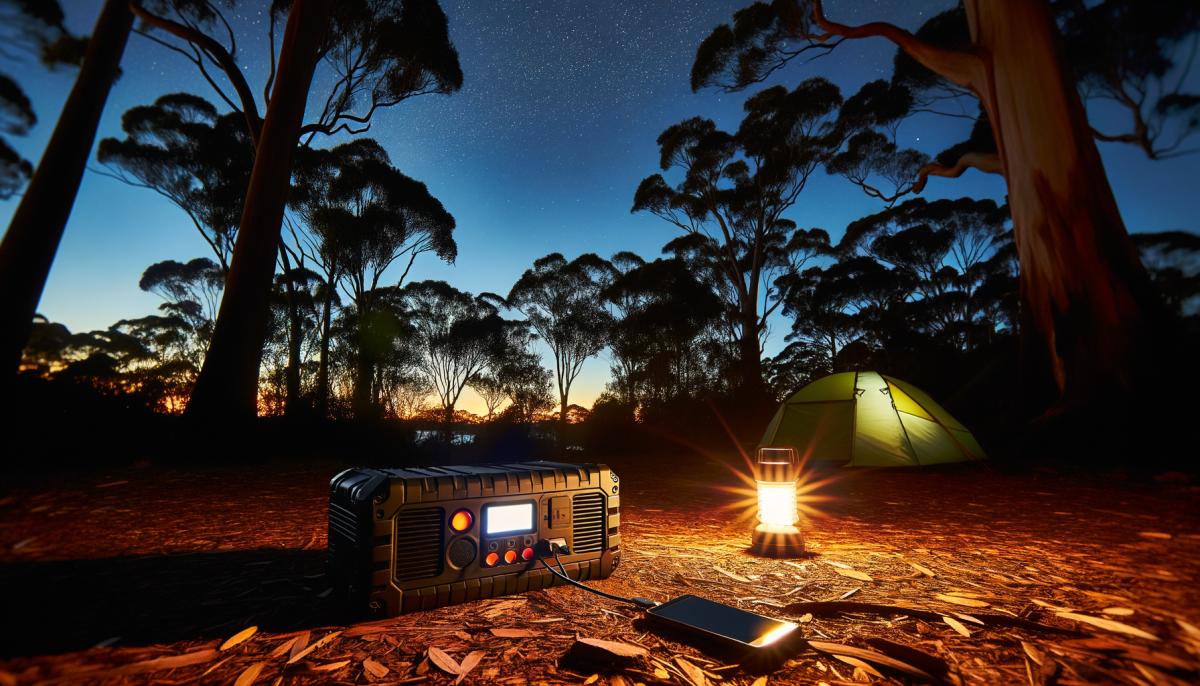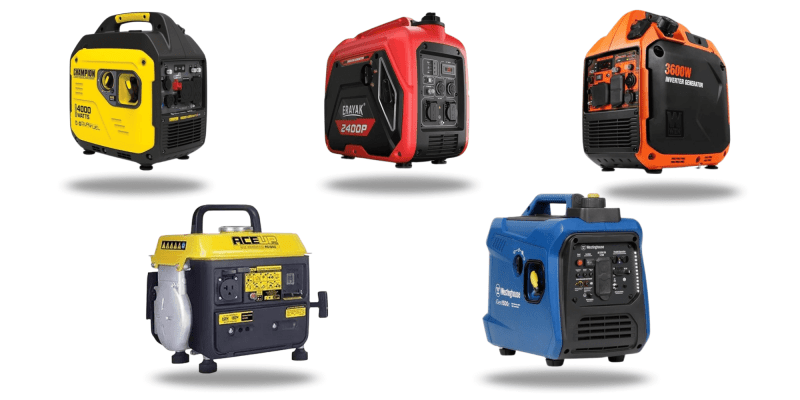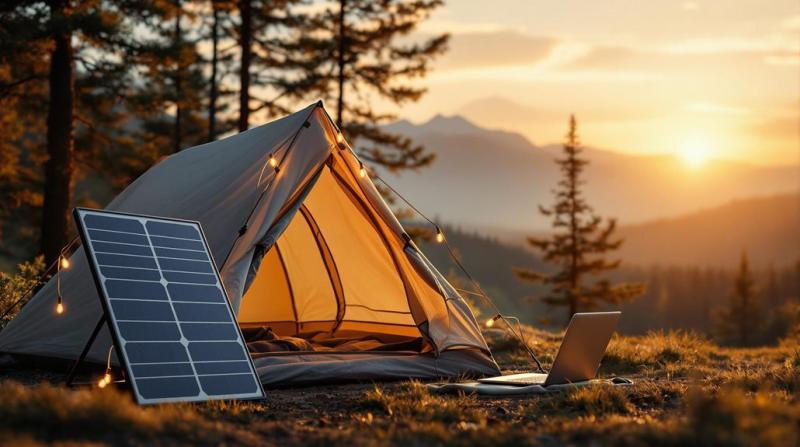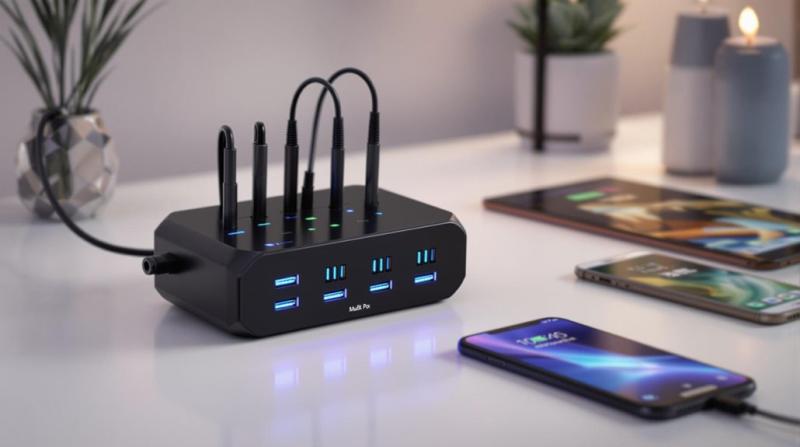Alright, so let's dive into finding the ideal battery life for camping power stations.
First off, you gotta get a handle on the different types of batteries out there. Lithium-ion batteries are the go-to choice for most camping gear. They can last through 500-1000 charge cycles and keep performing well even when the weather changes.
Now, if you want something even more robust, consider LiFePO4 batteries. These bad boys can handle up to 3,000 cycles at 80% capacity. That's a lot of juice!
But here's the thing: knowing your battery type is just the start. You also need to get the hang of battery maintenance, proper charging methods, and smart storage techniques. When you nail these down, you'll stretch that battery life way further.
Stick to these tips, and you'll make sure your batteries charge up efficiently, work like a charm, and stay reliable for years.
Battery Capacity Explanation
When you're picking out a power station for your camping trip, you definitely need to think about the battery capacity, which is measured in watt-hours (Wh). This number basically tells you how long your devices can keep running. The higher the capacity, the longer you can use your stuff and even power multiple gadgets at the same time.
For example, if you get a power station with a 1,000 Wh capacity, you can run a 100 W device for about 10 hours. That's pretty solid for most moderate power needs.
So, you might see power stations with capacities ranging from 300 Wh for smaller ones like the Jackery Explorer 300, all the way up to over 6,000 Wh for big guys like the Anker Solix F3800. These different capacities are great because they cater to all sorts of power needs. No matter what your camping requirements are, you can find one that fits just right.
Now, let's talk about battery life. The type of battery technology really matters. Lithium Iron Phosphate (LiFePO4) batteries are the go-to for outdoor use because they last longer—up to 3,000 cycles at 80% capacity. That means these batteries can handle a lot of charging and discharging, which is super important for camping power stations.
When you're choosing a power station, make sure to check both the capacity and the output rating. A higher output rating, like 1,000 W, lets you run big power-hungry devices like refrigerators or microwaves. And with a larger capacity, you can keep those devices running for a long time.
Maintenance for Optimal Life
To make sure your camping power station lasts as long as possible, you gotta keep up with some regular maintenance.
First off, try to keep the battery charge level between 60-80% when you're storing them. If you keep them fully charged all the time, you could lose about 20% of their capacity in just one year. So, you need to check and maintain their charge levels regularly.
Another thing you should do is keep an eye on the battery health by using them every now and then. For lithium batteries, it's especially important to cycle them every few months. This helps prevent deep discharge and keeps them performing their best.
Also, make sure to store your portable power station in a cool, dry place—somewhere around 60 degrees Fahrenheit is ideal. This helps minimize degradation and keeps the batteries in good shape for longer.
When you're using your power station, try not to charge all the batteries at the same time. Doing that can speed up the aging process and shorten their lifespan. Instead, focus on using energy-efficient devices. This not only makes the most of your battery life but also boosts the overall efficiency and longevity of the batteries.
Storage and Charging Tips
When you're not using your portable power station for camping, proper storage and charging techniques become super important to keep its battery life in good shape.
First off, you want to store it at around 40% charge. That's the sweet spot! And make sure you keep it in a cool, dry place. Ideal temperatures? Around 60°F (15°C). Not too hot, not too cold. Just right.
Oh, and don't forget to check and top off your lithium batteries every three months. It's a good habit to get into. This way, you can prevent deep discharge and ensure your batteries are always ready for your next camping adventure.
Happy camping!
Battery Maintenance
Effective battery maintenance starts with proper storage and charging techniques. For camping power stations, maximizing battery life relies on careful management.
When storing lithium batteries, aim to maintain a charge of around 40% for ideal longevity. This helps prevent significant capacity loss over time, making sure your batteries are ready to go when you need them for your camping trips.
Temperature and humidity? Yep, they're super important too. Store your batteries at about 60 degrees Fahrenheit, with humidity levels between 30-40%. This way, you avoid moisture damage.
Oh, and don't forget to regularly check your battery levels. Topping them off every three months is a good habit to get into. It helps to prevent deep discharge. And hey, charge your batteries before you stash them away for a long time. Fully charged batteries tend to lose less capacity compared to those stored at lower levels.
Always, and I mean always, refer to the specific manufacturer guidelines for storage and maintenance. Recommendations can vary depending on the battery type and model, so it's best to play it safe.
Optimizing Charging Methods
While it's super important to keep your camping power station in the right storage conditions, having good charging methods is just as crucial to keep that battery going strong.
So, when you're getting ready to store your power station for a long time, aim to charge your lithium batteries to about 40%. This helps minimize capacity loss. And hey, don't forget to check those battery levels and give them a little top-off every three months. You definitely don't want them to deep discharge, as that can really cut down their lifespan.
Want to get the most out of your battery? Make sure to use energy-efficient devices in your camping setup. A lot of portable power stations, like the ones from Jackery, can handle solar input. That means you can use solar panels to charge your power station, which is awesome for long outdoor trips. Plus, if you have lots of sunlight, why not take advantage of it? Not only does this keep your battery healthy, but it's also great for the environment.
Now, if you're rocking LiFePO4 batteries, they really love optimized charging methods. By controlling how you charge them, you can avoid overcharging and deep discharge—two big culprits in battery wear and tear.
With the right charging techniques and smart battery management, your camping power station can keep delivering reliable energy for years. So, go out there and enjoy the great outdoors without worrying about your power source!
Understanding Lithium-Ion Batteries
So, if you want to make the most out of lithium-ion batteries for your camping adventures, you gotta know a thing or two about them. These little powerhouses are what make your camping power stations tick. They're super efficient, reliable, and, best of all, they don't take up much space. Pretty cool, right?
Lithium-ion batteries are famous for their high energy density. This means they can store a ton of power while still being lightweight and compact. Perfect for when you're out in the wild and need something portable.
Now, here's an interesting bit. These batteries can go through a lot of charge-discharge cycles—like 500 to 1,000 cycles! Of course, this depends on how you use and take care of them. So, if you're the type who loves frequent camping trips, these batteries are just right for you. Plus, they perform consistently well across different temperatures. Whether it's hot or cold out there, you can count on them.
Wanna make them last even longer? Avoid draining them completely and store them at about 40% charge when you're not using them. Trust me, this little trick goes a long way. By doing this, you'll ensure these batteries keep delivering peak performance for a good long while.
Since most camping power stations these days use lithium-ion battery technology, knowing these tips can really help you get the most out of your gear. Happy camping!
Lead-Acid Battery Maintenance
So, you've probably picked up a thing or two about lithium-ion batteries by now. But hey, let's switch gears and talk about taking care of your lead-acid batteries. Trust me, a little TLC goes a long way with these guys. Seriously, proper maintenance can totally extend their lifespan.
First off, let's chat about preventing deep discharges. It's a big deal because letting your battery drain too much can really mess with its longevity.
And then there's the whole charging cycle thing. Keeping it in check is key.
Follow these tips, and you'll be golden. Your lead-acid batteries will thank you by lasting longer and performing like champs, especially when you're out camping and need that reliable power.
Deep Discharge Prevention
So, taking care of your lead-acid batteries is super important, and you really want to avoid deep discharges. You should always try to keep the state of charge above 50%. If you let it go below that, you could do some serious, permanent damage, and your battery's lifespan will take a hit. Imagine losing up to 20% of usable power within just a year because of a deep discharge cycle. Yikes!
Regularly checking the state of charge (SOC) can help you make sure your batteries stay above that critical discharge level. And hey, don't forget to recharge them promptly after use. If you leave them discharged for too long, they can suffer from sulfation. This nasty condition can really mess up your battery's performance.
To make things easier, you might want to consider using a smart battery charger with a built-in management system. This handy tool can optimize your charging cycles and help prevent those dreaded deep discharges. It's a great way to extend the lifespan of your lead-acid batteries.
Proper Charging Cycles
Hey there! Keeping your lead-acid batteries in tip-top shape is all about sticking to the right charging cycles. Seriously, you can't be too careful with this stuff. So, here's the deal: charge them fully after every use. This helps prevent sulfation, which is a nasty process that can cause irreversible damage over time.
Oh, and try not to discharge them below 50% of their capacity. Deep discharges? Yeah, they really cut down on the number of usable cycles. You don't want that. Also, make it a habit to check the electrolyte levels regularly. If they need topping up, use distilled water. It helps keep everything running smoothly.
When it's time to charge, go for a smart charger. These little guys use a multi-stage process, which means you won't have to worry about overcharging or overheating. Trust me, these common mistakes can really shorten your battery's life.
But if you stick to these guidelines, you can expect your lead-acid batteries to last anywhere from three to five years. And under ideal conditions, you'll get peak performance between 200 and 300 charging cycles.
Environmental Factors to Consider
Temperature and humidity are super important when it comes to keeping your camping batteries in tip-top shape. You know those lithium batteries we all love for our camping power stations? They really don't like extremes.
They're happiest when the temperature is between 14°F and 104°F. Too cold, and the battery's chemical reactions slow down, meaning less capacity. Too hot, and you risk overheating and permanent damage. Not ideal, right?
Now, let's talk about humidity. You want to keep it between 30-40%. If it gets too humid, the batteries can start to corrode. Not good! On the flip side, if it's too dry, you might run into static discharge problems, which can also be pretty bad.
And don't forget, direct sunlight is a no-no. It can heat up the batteries and shorten their lifespan. So, keep an eye on your environment. Fluctuations can mess with the battery chemistry and performance. A stable environment is your best bet for making those batteries last longer.
Here's a pro tip: to keep moisture at bay, store your batteries in airtight containers with desiccants. This is especially handy on camping trips where you're more exposed to the elements.
Performance Over Time
When you're out camping, you want your portable power station to be reliable and efficient, right? Well, its performance over time is crucial for those outdoor adventures. The lifespan of these power stations mainly hinges on the type of batteries they use. You'll often find Lithium-ion and LiFePO4 batteries in camping power stations. Fun fact: LiFePO4 batteries tend to last longer and can handle more charge cycles.
Now, here's the deal. How you use and maintain your power station can make a huge difference. If you're constantly using it and charging it up, the battery will wear out faster. You'll notice the capacity to hold a charge dwindling, which means it won't power your gadgets as long during those trips.
So, what's the best way to keep your power station in tip-top shape? A few simple steps can go a long way. For starters, try to store your batteries with a charge level of around 60-80%. This reduces the strain on the battery and helps it last longer. And don't forget about temperature! Keeping them in a range of 14-104°F is key.
Also, keep an eye on those battery levels. Recharging before they dip below 20% can help maintain performance and extend battery life. Try not to let the battery fully discharge and steer clear of extreme temperatures when using or storing your power station.
Following these tips can really help extend the life of your camping power station. So, you'll have reliable energy support for all your outdoor adventures!



